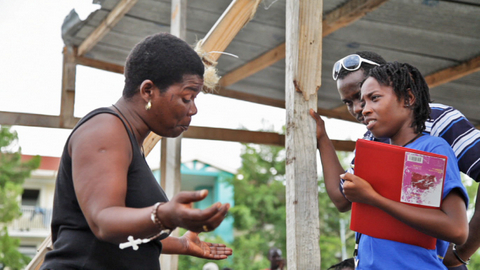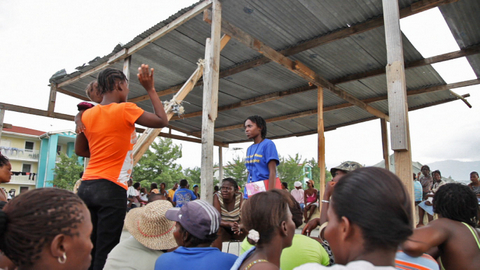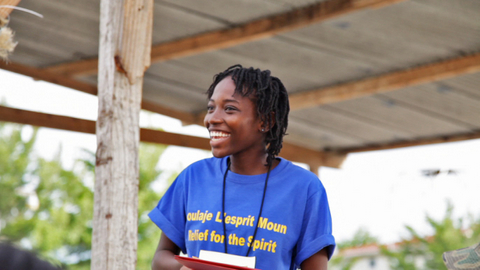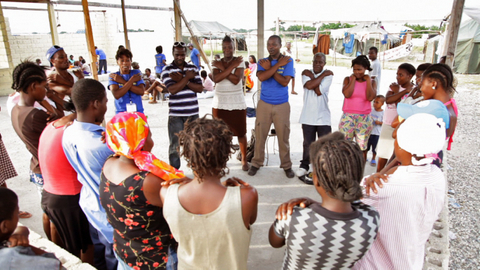
On a recent visit to Haiti, I sat down with ten young Haitians who are working as mental health workers in the refugee camps of Port-au-Prince. Six months after the devastating January 12 earthquake, the experiences of that day -- the terror and the losses -- remain vivid and present in the minds of all Haitians. Nearly everyone has some degree of post-traumatic stress: hyper-vigilance, startled responses, sleep difficulties, intrusive memories, and fear, anxiety, grief, and anger are widespread.
The young people I met with are part of an innovative project begun in late April by the Aristide Foundation for Democracy, in cooperation with a group of social workers and doctoral students from the University of Michigan, to provide mental health workshops to earthquake survivors in the camps. In late April, ten extraordinary young Haitian college students received training from Leah James, a PTSD specialist, social worker and doctoral candidate at the University of Michigan. (Read Leah's Huffington Post blog post describing the evolution of this project). A Haitian psychologist signed on to advise the project, and provide ongoing mentoring, and together the group created a culturally appropriate 90-minute psycho-education and coping skills workshop, which they have been leading in camps in the earthquake zone for the past twelve weeks.

On the day we met, one-by-one these young Haitians raised a hand to offer testimony. A slight, studious young woman of no more than 22, began by saying she never imagined she could do something like this. The work was hard. The initial reception in the camps had been rough. People were hungry and understandably skeptical about a project that offered mere words. With time though, she said, they'd made inroads. Now, some of the people who'd initially been most skeptical were regulars at the sessions, or regularly brought other people to the workshops. Many, many people returned to tell them they slept better after participating in the sessions, and after doing the regular breathing and self-soothing exercises that are a key component to the trainings. Some participants reported that headaches or body aches were eased, and many people described improved relations with their families. Several people who were drinking or doing drugs to escape the grief and the trauma returned to tell the mental health workers that they'd decided come to talk instead.

She went on to say this work had transformed her. She would never forget the suffering she had witnessed in the camps. But it had transformed her. She was stronger than she'd imagined she could be. She described an encounter with a woman who had lost her only child in the quake. This woman had heard her daughter's calls from under the rubble, but she had not been able to save her. Now she had no will to live -- the daughter had been her only hope in life. The mental health workers didn't know what to do. They themselves were overwhelmed with emotion on hearing this story and bearing witness to this women's pain, though they struggled not to show it. "All four of us who were there, we just put our hands on her and repeated over and over, you are alive, you are alive. That was the most powerful experience of my life."
Another mental health worker told of a woman who came to a session had been estranged from her husband since the quake. Part of the instructions in the mental health workshop is to go home and do the relaxation exercises with your family each night. Despite the estrangement, this woman had taken the direction to heart and so sought out her husband in the camp where both were living. She taught him the breathing and relaxation exercises she had learned -- this in turn led to a reconciliation, which was then celebrated by the whole camp.
A common reaction to the trauma of the quake, which the mental health workers call attention to, is difficulty in showing affection. One of the young mental health workers described how as they came to this part of the training, a woman had nodded in amazement and said, "It is like you are describing me." She'd been having a terrible time with her daughter, who had been misbehaving since the quake. But she also realized she herself had been distant, and hadn't been affectionate with the child. She came back two days later to tell them that she had spent time with the child, rocking her and putting her to bed that night. Since then the child's behavior had dramatically improved; she was, once again, the sweet, helpful child she'd been before the quake.
All of the staff at the Aristide Foundation had participated in these workshops early on and I was struck by how seriously they all took the relaxation exercises. I asked what they thought of the training they'd received. Wasn't it all talk? 'No, no' several of them assured me, they did they exercises religiously, every night with their children and partners. Especially the butterfly hug, one staffer told me, wrapping her arms around herself, a look of calm coming over her face as she did it -- she especially liked the butterfly hug.

Gladys, a long time staff member of the foundation who I've known since 1996, told me that the night after the first workshop she did with Leah was the first night she was able to sleep inside her house. Her house was not damaged, but like nearly everyone in the city, she'd been sleeping in a tent for fear of another quake. She decided to go inside, because "you have to live." She also told me she was able, after the training, to go downtown to the area of the Palace of Justice, where she had been having her hair done at the moment of the quake. The Palace of Justice completely collapsed, taking the beauty shop she was in with it. She scrambled to get out -- she made motions with her elbows, pushing forward, as if she were crawling, to show me how. Somehow she escaped the building. Just that past week Gladys had learned that the woman who had been sitting in the next chair next to her having her hair done, had been killed. Before the workshop each time she had approached the area around the Palace of Justice, she'd veered away. After the session she went back and took a good look at the place she had been. She still didn't know how she got out.
Perhaps of all the stories I heard, Frederick's was the most striking. Frederick was not technically a member of the mental health worker team. Solon, the Haitian psychologist who is mentoring the project had asked Frederick to translate during the trainings back in April, as Frederick is a language professor. But it turned out Solon had a secondary reason for inviting him -- he knew Frederick was suffering as well. Frederick, whose face I can only describe as radiant, began by saying, "You know when I first came to the training I was not well. That first day I could not even translate. For weeks after the quake, I was not myself." Frederick went on to tell his own story. At the moment of the quake he had been in a classroom teaching at the National University where he worked. The entire building had collapsed and over 200 people died there including many of the students in his classroom, colleagues and the beloved dean of the school. He had witnessed these deaths and somehow escaped.

In April, as schools were reopening, he was called on to go back to teaching. He did not know if that was possible; he was barely functioning, he kept seeing images of walls collapsing, bodies mangled. Plus to be in front of a classroom would be to reenact the moment of the trauma. But, he said, the time he spent translating in the trainings following the work of the Lay Mental Health workers, doing the relaxation exercises, and talking with Solon, had brought him back to himself. He reported that he was now back teaching in ad hoc facilities. What is more, every day he led his students through the relaxation exercises. The students, in turn, took the exercises home to their families. Frederick was now an adopted member of the Lay Mental Health Worker group, and perhaps its biggest evangelist.
The conditions of life for those who survived the quake are terrible. They need food and they need shelter -- and the international aid effort has failed them. But there is also a deep hunger to tell their stories, to find solace in the midst of suffering, and to come together in community. The young mental health workers are of course all earthquake survivors themselves; many lost friends and family members. Yet they were the most energized, vibrant group of people I've met anywhere in a long time. The work they were doing seemed in and of itself to protect them from the despair that threatens the country.